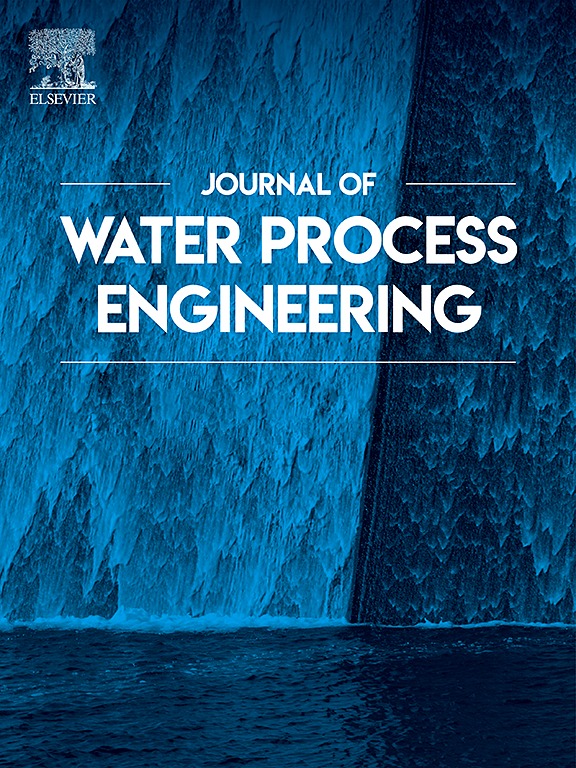Engineering properties of hydrochar fabricated from hydrothermal carbonization of lignocellulosic biomass: Practice as adsorbent and catalyst in water treatment
IF 6.7
2区 工程技术
Q1 ENGINEERING, CHEMICAL
引用次数: 0
Abstract
The conversion of waste biomass into value-added products, energy, and materials is a key strategy for establishing a circular bio-economy and achieving sustainable technological development. Among various waste valorization techniques, hydrothermal carbonization (HTC) has emerged as a promising method due to its distinct advantages, including high efficiency and versatility in processing both lignocellulosic and non-lignocellulosic biomass. HTC enables the transformation of biomass into hydrochar, a carbonaceous material with significant potential in energy production, biofuels, and environmental remediation. This review highlights the optimization of HTC processes and strategies for enhancing hydrochar's engineering properties through surface functionalization. Special emphasis is given to the fabrication of adsorbents and catalysts from hydrothermal carbon, enabling the effective removal of emerging contaminants such as dyes, pesticides, pharmaceutical compounds, and heavy metals. Additionally, the modification of HTC carbon into fine and granular forms maximizes its adsorption and catalytic efficiency. The utilization of pelletized HTC carbon as a solid fuel and soil amendment further underscores its environmental and economic significance. With its unique properties—oxygenated functional groups, high surface area, hydrophobic nature, and conductivity—HTC carbon can be further enhanced through nanomaterial functionalization and composite support matrices, broadening its applicability in sustainable waste management and resource recovery.

木质纤维素生物质水热炭化制备烃类的工程性质:在水处理中作为吸附剂和催化剂的实践
将废弃生物质转化为增值产品、能源和材料是建立循环生物经济和实现技术可持续发展的关键战略。在各种废物增值技术中,水热碳化(HTC)因其在处理木质纤维素和非木质纤维素生物质方面的高效率和通用性而成为一种很有前途的方法。HTC能够将生物质转化为碳氢化合物,这是一种碳质材料,在能源生产、生物燃料和环境修复方面具有巨大潜力。本文重点介绍了通过表面功能化提高碳氢化合物工程性能的HTC工艺和策略的优化。特别强调从水热碳制备吸附剂和催化剂,使其能够有效地去除新出现的污染物,如染料、农药、药物化合物和重金属。此外,将HTC碳改性为细颗粒形式,使其吸附和催化效率最大化。HTC碳颗粒作为固体燃料和土壤改良剂的利用进一步强调了其环境和经济意义。htc碳具有氧化官能团、高表面积、疏水性和电导率等独特性能,可以通过纳米材料功能化和复合支撑基质进一步增强,扩大其在可持续废物管理和资源回收中的适用性。
本文章由计算机程序翻译,如有差异,请以英文原文为准。
求助全文
约1分钟内获得全文
求助全文
来源期刊

Journal of water process engineering
Biochemistry, Genetics and Molecular Biology-Biotechnology
CiteScore
10.70
自引率
8.60%
发文量
846
审稿时长
24 days
期刊介绍:
The Journal of Water Process Engineering aims to publish refereed, high-quality research papers with significant novelty and impact in all areas of the engineering of water and wastewater processing . Papers on advanced and novel treatment processes and technologies are particularly welcome. The Journal considers papers in areas such as nanotechnology and biotechnology applications in water, novel oxidation and separation processes, membrane processes (except those for desalination) , catalytic processes for the removal of water contaminants, sustainable processes, water reuse and recycling, water use and wastewater minimization, integrated/hybrid technology, process modeling of water treatment and novel treatment processes. Submissions on the subject of adsorbents, including standard measurements of adsorption kinetics and equilibrium will only be considered if there is a genuine case for novelty and contribution, for example highly novel, sustainable adsorbents and their use: papers on activated carbon-type materials derived from natural matter, or surfactant-modified clays and related minerals, would not fulfil this criterion. The Journal particularly welcomes contributions involving environmentally, economically and socially sustainable technology for water treatment, including those which are energy-efficient, with minimal or no chemical consumption, and capable of water recycling and reuse that minimizes the direct disposal of wastewater to the aquatic environment. Papers that describe novel ideas for solving issues related to water quality and availability are also welcome, as are those that show the transfer of techniques from other disciplines. The Journal will consider papers dealing with processes for various water matrices including drinking water (except desalination), domestic, urban and industrial wastewaters, in addition to their residues. It is expected that the journal will be of particular relevance to chemical and process engineers working in the field. The Journal welcomes Full Text papers, Short Communications, State-of-the-Art Reviews and Letters to Editors and Case Studies
 求助内容:
求助内容: 应助结果提醒方式:
应助结果提醒方式:


